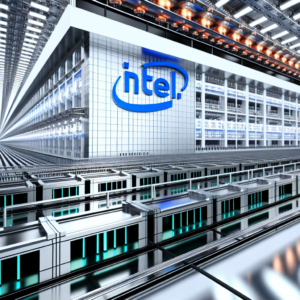Activities
Divisions
Programs
Activities
Divisions
Programs
Intel plans to construct the biggest AI chip plant globally in the US, with over $100 billion investment spread across four states
Pat Gelsinger, Intel's CEO, intends to establish the world's most extensive AI chip production facility near Columbus, Ohio. This AI chip plant will be the focal point of Intel's aggressive five-year investment strategy for US expansion.
Intel has unveiled a significant $100 billion investment strategy spanning four US states, with the goal of building and enlarging its silicon chip production facilities.
This action was taken after obtaining $19.5 billion in federal funding and loans, with the aim of achieving a further $25 billion in tax advantages. The focal point of Intel's aggressive five-year financial strategy is the creation of what CEO Pat Gelsinger refers to as "the world's biggest AI chip production facility" close to Columbus, Ohio. The facility is expected to start functioning as soon as 2027.
The American government's decision to provide federal money to Intel through the CHIPS Act highlights the country's dedication to strengthening its homegrown semiconductor production abilities.
Intel's investment plan includes updating its sites in New Mexico and Oregon, as well as increasing its business activities in Arizona. This is the same area where its competitor, Taiwan Semiconductor Manufacturing Co (TSMC), is growing its operations with the backing of President Joe Biden's semiconductor production program.
The Biden administration's initiative to rejuvenate chip manufacturing is set to considerably strengthen Intel's competitive edge. Intel has traditionally been a powerhouse in the semiconductor manufacturing sector, channeling its profits back into research and development to preserve its tech dominance.
Nonetheless, in the past few years, the company has encountered difficulties, losing territory to rivals such as TSMC and witnessing a fall in profit margins.
Gelsinger, who in 2021 presented a strategic blueprint to restore Intel's leading status, has underlined the crucial role of governmental aid in successfully implementing the plan with profits. Now that federal support is assured, Intel is ready to launch a major spending surge. Roughly 30% of the $100 billion is allocated for building costs, encompassing labor and infrastructure.
Intel's investment strategy also involves acquiring state-of-the-art semiconductor manufacturing equipment from industry frontrunners like ASML, Tokyo Electron, Applied Materials, and KLA.
These investments are essential to get the Ohio facility up and running by 2027 or 2028. However, Gelsinger warned that the schedule could be affected by market conditions.
Experts in the industry predict that Intel will need somewhere between three to five years to become a significant competitor in the advanced chip foundry sector. They also mention that Intel would have to increase its investment to outshine TSMC, who is predicted to retain its top spot in the market in the upcoming years.
Gelsinger emphasizes the importance of ongoing government assistance to maintain the United States' leading position in semiconductor production. Even with support from federal programs, Intel is under stress to prove its competitive edge against foreign competitors, specifically those in Taiwan and South Korea.
Despite this, Intel remains vitally important to the US due to its large employee base, advanced technology, and domestic supply network. Although rivals such as TSMC and Samsung are increasing their footprint in the US, Intel's ongoing dominance in the semiconductor industry is considered essential for a strong homegrown technology sector.
(Incorporating information from various sources)
Look for us on YouTube
Highlighted Programs
Connected Articles
In a few months, OpenAI will debut GPT-5, marking the closest we've come to AGI so far.
Pakistan rejects US claims of election manipulation, stating that Washington fails to comprehend Islamabad's political landscape.
Google leverages AI to accurately forecast floods a week before they occur.
Indian restrictions on the importation of laptops and tablets have put US tech companies under pressure, prompting Washington to advocate on their behalf to the Indian government.
OpenAI is set to introduce GPT-5 in the coming months, a development that will be the most similar to AGI that we've witnessed to this point.
Pakistan dismisses allegations from the US about election tampering, arguing that Washington doesn't fully grasp the political circumstances in Islamabad.
Google employs AI to successfully anticipate floods seven days prior to their arrival.
US tech firms are feeling the heat due to India's import restrictions on laptops and tablets, leading Washington to lobby the Indian government.
Available on YouTube.
Firstpost holds all rights reserved, copyright © 2024.


























+ There are no comments
Add yours